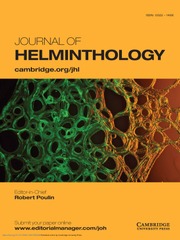Article contents
Changes in the excretory bladder ultrastructure during the morphogenesis of Levinseniella brachysoma metacercariae
Published online by Cambridge University Press: 05 June 2009
Abstract
For the first time the development of the excretory system Levinseniella brachysoma metacercariae (Trematoda: Microphallidae) obtained experimentally from Gammarus oceanicus has been described. The bladder wall of 8-day post-infection (P.I.) larvae consists of a syncytium covered with microvilli. Its cytoplasm contains well-developed rough endoplasmic reticulum (RER), free ribosomes, small oval dense mitochondria and numerous large membrane-bounded (about 5 μm in diameter) spherical granules. Later the size of the excretory bladder and the number of nuclei and RER cisternae increases. The large spherical granules disappear completely but spherical dense bodies (up to 4 μm in diameter) devoid of limiting membranes appear. The bladder lining forms thick columnar projections directed towards its lumen. Accumulations of microlamelli occur only on the lumen surface between adjacent projections. By the 42nd day P.I. the bladder wall has two separate components: the columnar projections and the syncytium between them.
- Type
- Research Papers
- Information
- Copyright
- Copyright © Cambridge University Press 1995
References
- 3
- Cited by


